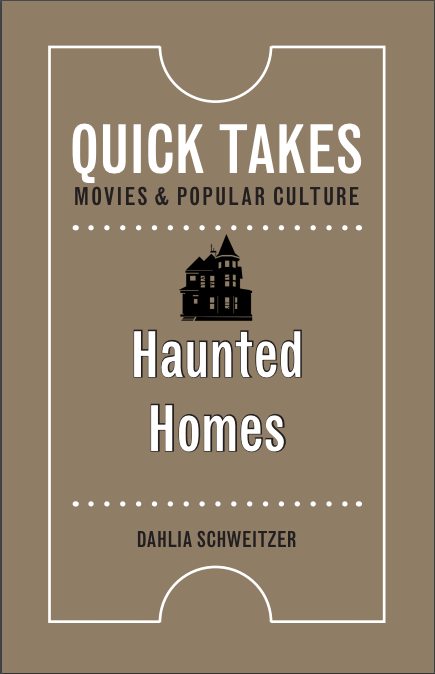The following is an excerpt from my forthcoming book Haunted Homes, out June 2021 via Rutgers University Press.

“Even serial killers live next door to somebody.”
—Summer of 84
Haunted houses feel as much a part of Halloween as pumpkins and costumes. It can be hard to remember where you first saw a haunted house or how old you were the first time you went inside one. They are ubiquitous and generic, commercialized, commodified, and caricatured. Because of their ability to scale up the horror from kid-friendly “eyeballs” in a bowl all the way to actual violence, as in the case of McKamey Manor in Tennessee and Alabama, haunted houses continue to draw in crowds looking for a thrill.
A haunted home is something different entirely. Unlike the term “house,” which describes a building’s style and purpose, the word “home” refers to something more personal and emotional. The concept of “home” directly involves the people who live inside, whereas “house” merely refers to the structure itself, to the walls and the way they are put together. A home does not need to be a house; it can be an apartment or a boat or a trailer or a cardboard box. A home is where someone feels as though they belong, where they feel safe, where they feel most truly themselves.
Many discussions of horror films—and specifically those set in the domestic arena—tend to be ahistorical, treating modern-day narratives as though they are simply a continuation of European Gothic novels from the eighteenth century. However, this simplification does a disservice to the particular nuances of the haunted home narrative, a style of storytelling uniquely tied to the evolution of the suburban United States and the suburban home specifically.
For almost a century, Hollywood has been delivering memorable portrayals of evil homes full of lingering trauma, malevolent ghosts, and sometimes even portals to hell. While Paul Leni’s The Cat and the Canary (1927), in which a family is terrorized in a creepy mansion, may have been the first film to establish the look and feel of the “haunted home,” other films—such as James Whale’s aptly titled The Old Dark House (1932), in which travelers taking solace from rain are terrified by the residents of yet another creepy mansion, as well as Lewis Allen’s The Uninvited (1944), in which a brother and sister impulsively buy an abandoned house, only to discover that it comes with ghosts—kept expanding its parameters. More recently, the success of Mike Flanagan’s Netflix series The Haunting of Hill House (2018), loosely based on Shirley Jackson’s novel of the same name, in which a family revisits the haunted home of their youth, as well as movies like Ari Aster’s Hereditary (2018), in which a family is haunted by evil spirits, demonstrates the continued appeal of watching sinister forces encroaching on the domestic front.
Sometimes these forces are literal, sometimes they are confined to nightmares and dreamscapes; but the end result remains the same: home is where the horror is. This premise is all the more remarkable since homes are traditionally equated with safety and sanctuary. After all, when do you feel more safe than when you return home, letting the door close behind you, the outside world kept at a distance? However, the template of the “haunted home narrative” plays precisely on the paradox of that premise, bringing fear into the otherwise placid home, perverting the satisfying accomplishment of the American dream with abject terror and financial—if not also physical—ruin.
But why? On the one hand, we have persistent messaging that suburbia is bliss, full of happy families, green lawns, and well-adjusted children, even if also a bit boring and homogeneous. On the other hand, however, we have the stubborn appeal of movies and television shows determined to show us that that bliss is a lie, that true horror begins (and ends) at home, and that safety will never be achieved until the family house—that ultimate indicator of American success and status—is shrinking in the rearview mirror.
This book examines not only the growth of the suburban neighborhood but also its long-term impact on American identity and the American family as depicted in US film and television. Suburbia is not just an architectural choice or geographic preference. Suburbia establishes and reinforces specific modes of behavior, not all of which come with messages of opportunity and hope. It shifts focus to the family while, at the same time, isolating the family—from other people and the individual members from each other. It is a fundamental rethinking of the relationship between city and home, between husband and wife, between job and family, between private and public space. While most are of the texts discussed in this book are set in stereotypical American suburbia, not all are. For example, the film and television adaptations of Shirley Jackson’s novel The Haunting of Hill House are set in an isolated nineteenth-century mansion rather than in a modern suburban home, the haunted homes in The Innocents (Jack Clayton, 1961) and The Witch (Robert Eggers, 2015) are situated in presuburban pasts, and a handful of movies discussed in this book are located outside the United States, such as The Uninvited (Lewis Allen, 1944) and The Babadook (Jennifer Kent, 2014). I have opted to include these films for the effective ways they depict my arguments. For instance, once you understand how the family is literally isolated in a nineteenth-century mansion, it is easier to understand and observe more contemporary incarnations of this same isolation.
As Davey Armstrong (Graham Verchere) explains in the Summer of 84 (François Simard, Anouk Whissell, and Yoann-Karl Whissell, 2018), “Just past the manicured lawns and friendly waves, inside any house, even the one next door, anything could be happening, and you’d never know. . . . It all might seem normal and routine, but the truth is the suburbs are where the craziest shit happens.” This book is about that crazy shit and what it tells us about ourselves.

Recent Comments